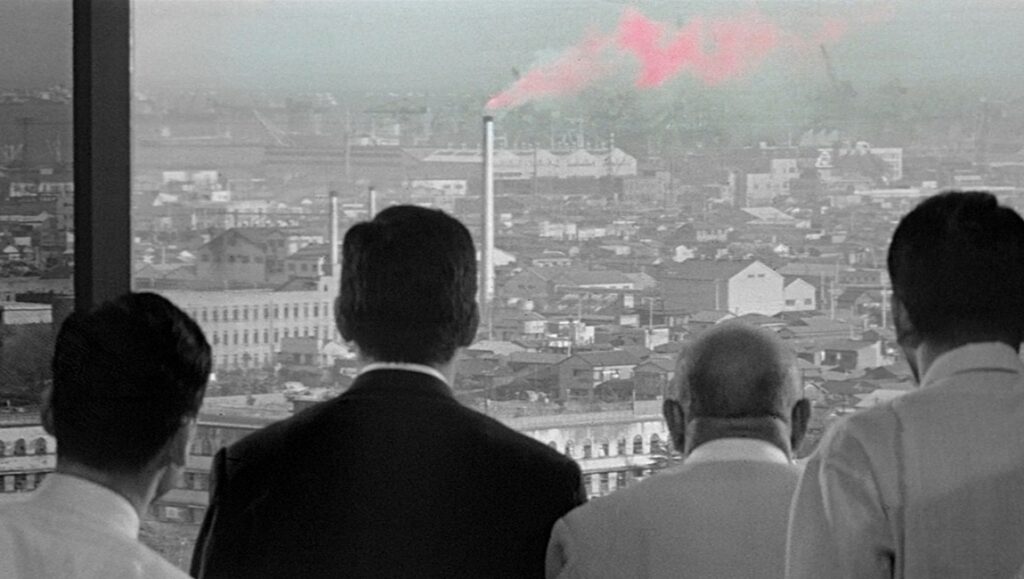When High and Low was released in 1963, Akira Kurosawa had been working his way through some of the world’s great literary works for quite some time: the ’50s saw him adapt the words of Ryunosuke Akutagawa (Rashomon), Fyodor Dostoevsky (The Idiot), and William Shakespeare (Throne of Blood) to the big screen. By the ’60s, following a sustained period of critical and commercial success, the Japanese filmmaker opted to look beyond the canon of high literature and toward the world of mass-market paperbacks, namely the 1959 crime novel King’s Ransom, written by Evan Hunter (better known under his pen name, Ed McBain).
Kurosawa takes the book’s pulpy police procedural plot and transforms it into a film of two halves: the first concerning the kidnapping of a young boy, and the second focused on the cops’ hunt for the perpetrator. Toshiro Mifune’s Kingo Gondo dominates the first hour of High and Low‘s 143-minute runtime. Introduced as a shrewd, highly principled executive of a shoe company — in the introductory scene he refuses to cheapen his product in order to drive up sales — he has secretly been working to gain control of the company, leveraging all his possessions (including his luxurious villa perched atop a hill overlooking Yokohama) for 47% of the shares. The risky move is about to pay off when his chauffeur’s son is kidnapped. Although the kidnapper intended Gondo’s son to be the target, he nevertheless demands 30 million yen from him, threatening to kill the boy if he doesn’t comply.
Immediately, the film opens up its investigation into social dynamics and ethical quandaries. Gondo wrestles with his conscience, knowing that paying the ransom would mean far more than just an end to his plan to take over the shoe company — it would ruin him and his family completely. Mifune plays Gondo with a severity that belies his insecurity and anxieties about social decline. Gondo, at first, seems to represent a Randian hero of sorts, a capitalist übermensch who clawed his way out of poverty and into a life of luxury and economic power (“He’s an excellent boss,” insists one of his workers. “If you do a good job.”). Upon inspection, however, the myth crumbles — as does his moral compass once he is forced outside the realm of black-and-white morality — when High and Low reveals it was actually his wife’s family wealth that enabled him to ascend to a higher social strata.
Early on, these wrinkles are introduced almost entirely within the confines of Gondo’s spacious mansion, a location Kurosawa brings alive with long takes and frequent movement, filling the frame with Gondo’s business associates, employees, wife and son, and the cops, led by Inspector Tokuro (Tatsuya Nakadai). Gondo’s dilemma is made all the more urgent by his chauffeur’s pleas for his son’s life and Gondo’s belief that, without the money, his family would crumble as his wife, used to a life of upper-class comforts, would be unable — or perhaps unwilling — to adjust to poverty.
Flanked by the savvy cops, Gondo eventually works out a plan to save the kidnapped boy, a plan that involves filling two small briefcases with the ransom money and throwing them out of a moving train. Adding to the scene’s numerous moving parts is the police’s idea of covertly filming the perpetrators from the moving train — a detail echoed in Yoshimitsu Morita’s 1996 romance film Haru — in hopes of identifying them later. The sequence functions as a kind of transitional moment, one that transfers the focus from Gondo to Inspector Tokuro and his team. It’s a shift that takes the audience from the air-conditioned living room of Gondo’s house — the sweltering summer heat is frequently referenced throughout — all the way to dark, dirty alleys filled with squalor, drug addiction, and violence.
The kidnapper remains shrouded in mystery for most of the film, with no indication given as to what motivated his crime. But when Gondo finally comes face to face with him, he offers that it was desperation that compelled him to do what he did. “I’m not interested in self-analysis,” he says defiantly. “But I do know my room was so cold in winter and so hot in summer I couldn’t sleep. From my tiny room, your house looked like heaven. Day by day I came to hate you more.” Gondo, whose life was indeed upended by the whole saga, appears to have been softened by the experience, blinking back tears as he listens to the young man’s angry confession. In a shot that recalls Ingmar Bergman’s Persona (1960), Kurosawa captures Mifune’s reflection in the glass that separates the two men, framing his translucent face next to that of the malefactor, his mien heavy with melancholy and recognition.
It seems strange to call an acclaimed film by one cinema history’s most revered filmmakers “underdiscussed,” but given the fact that Kurosawa is most associated with the samurai film, those have sometimes overshadowed his other work. And even amongst his crime thrillers, it’s 1949’s Stray Dogs that went on to inspire remakes and re-imaginings, including Johnny To’s PTU (2003). High and Low‘s dense artistry has made direct remakes far less likely — how many films manage to provide a panoramic view of society while also successfully operating as a tense genre flick? — but its portrayal of a society coming apart amidst wealth disparity, class resentment, and crime feels just as urgent today as it did 60 years ago.


Comments are closed.